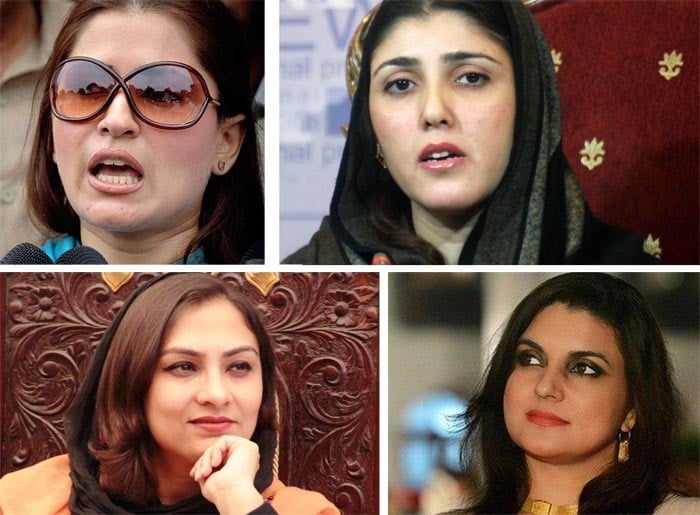
It is time to look at the idea of reserved seats for women to see if and how has it benefited the system. And are there any alternative ways to improve women’s participation in politics

Two sitting ministers of PML-N uttering foul and sexist remarks against a woman legislator and women participants of a political rally serve as the context of this discussion. Their remarks give some idea of why exactly women are under-represented in politics, political parties and parliaments.
In a recent newspaper article, Tahir Mehdi points out that reserved seats, largely of women, are majorly responsible for the current round of defections. Shocking as it might seem, the piece explains it is the absence of geographical constituency that takes away the burden of accountability off these legislators. The women on reserved seats just toe the party line and the party is in turn free to manipulate them at will.
What is of greater concern is, as pointed out in the article, the fact that the political parties are not obliged to re-elect these women on reserved seats; thus, there are only a handful of legislators that have returned to the assemblies in the last three or four general elections. Even with the elite political family affiliation argument, the parties find women candidates as easily disposable, denying the women legislators this opportunity to use their experience in the field in the forthcoming years.
Besides, there are many instances of women being barred from voting in elections, ranging from constituencies in Dir to those in central Punjab. It’s interesting how political parties that disallow the women from voting are quite forthcoming in nominating women on reserved seats.
It is, perhaps, time to look at this idea of reserved seats for women in our context more critically to see if and how has it benefited the system. If it hasn’t, where did it go wrong? And are there any alternative ways to improve women’s participation in politics.
Clearly, then, from what’s been said above, the reserved-seats-for-women formula is not working in Pakistan as it should. A wider debate needs to take place before such half-hearted measures that have proved counter-productive, especially when party heads choose women legislators to cross the floor for petty political ends.
There has been an argument that it is critical to problematise the issue; it is how you frame the issue of representation of women that is important. Thus, we need to first understand why there is under-representation of women in politics. Unless you know and address the causes, you cannot impose quotas because they will not yield the desired results. Once you know the problem, only then can you know what the solution is and who is better equipped to provide it.
From what we see in Pakistan, it is clear that gender equality is a notion that is not internalised by the society at large; in this case, the voters, the political parties and the legislatures. It is important to understand that even if Rana Sanaullah and Abid Sher Ali, the two ministers referred to above, exposed their own misogynist mindset, why were they not concerned about the 50 per cent women voters in this country, or in their own constituencies?
The apologies that have been quick in coming from within the party prove that sexism in politics, whenever it is uttered, is now rebuked with full force. One also hopes that women going to PTI rallies in droves question the male supremacy in politics; just as one hopes the right noises created by PPP are as meaningful as they appear.
On ground is a different scenario, historically. Politics has remained a male-dominated field. The affirmative action that began with the 1973 constitution, when a certain number of seats were reserved for women, was only for a period of three terms or ten years whichever came later. Just like in quotas, the idea was to lift the historically marginalised forces, including women, and gradually the system will rectify itself. Also, it was the 1970s that threw many women on the forefront of politics and not only from the ruling party’s platform, in streets and mohallas, some of whom we see even till now.
Unfortunately, these gains could not be crystallised because then came the regressive 1980s. The 1990s brought forth two or three odd women, from established political backgrounds, to the parliament. Then came the general and his reforms. The revolutionary 33 per cent seats reserved for women for local government and 17 per cent for provincial and national assemblies under Pervez Musharraf would have made you think things will actually turn around for the women and the system. Nothing of the sort happened.
People in this part of the world hold this perception that the Scandinavian countries have achieved numbers followed by qualitative change in politics through reserved seats for women in their parliaments. This isn’t wholly true. They have followed what is called the "incremental track", "resting on a gradual increase in women’s representation". The improvement has come largely after 1970 and it has come slowly, building on many socio-economic, institutional and cultural factors.
Read also: Is 10 per cent enough?
Everybody realises that political parties are an extremely important institution whose structure and ideology can have a transformative effect on the system. This is where Pakistan lags behind. But, even before that, you need education for women, their participation in the labour market and welfare systems that enable them to become a critical questioning female electorate.
It is this female electorate which will determine the future course of our politics. To create that electorate, we need to think collectively as a society.